Sulfate Resistance in Cements Bearing Ornamental Granite Industry Sludge
Abstract
:1. Introduction
2. Materials and Methods
2.1. Materials
2.2. Blends
2.3. Methodology
2.4. Instrumental Techniques
3. Results & Discussion
3.1. Specimen Variation in Mass with Soaking Time
3.2. Cement Paste Surface
3.3. Sulfate Resistance
3.4. Variation in Pore Structure
3.5. Composition and Microstructure
4. Conclusions
- -
- All of the cement pastes exposed to external sulfates deteriorated further to the mechanism associated with sulfate attack.
- -
- The OPC and OPC + 10GS pastes exhibited the same level of damage, whereas deterioration was more severe in paste OPC + 20GS. Therefore, the macroscopic classification for the former two was 0, ‘no damage’, and for the latter Mi, ‘minor damage’.
- -
- Microcracking was observed in the 180 days-soaked pastes prepared with 20% GS (OPC + 20GS).
- -
- Sulfate and sodium ingress into the paste microstructure translated primarily into ettringite formation inside pores and gypsum plate precipitation, densifying the cementitious matrix.
- -
- Matrix densification, which refined the pore system, inducing late age weight gain, was more intense in the pastes bearing GS as a result of the slow pozzolanicity of that material.
- -
- Under the present experimental conditions, the Köch–Steinegger corrosion index found for the 56 days-soaked samples was higher than the minimum needed to qualify as sulfate resistant.
- -
- Strength under sulfate attack (corrosion index) was higher in the OPC + 10GS pastes than in OPC, where it was higher than in paste OPC + 20GS.
- -
- OPC + 10GS cements can be used as alternative binders in the design and construction of non-structural cement-based (mortar or concrete) members that were exposed to an external source of sulfates.
5. Limitations of the Study
Author Contributions
Funding
Acknowledgments
Conflicts of Interest
References
- Medina, G.; del Bosque, I.F.S.; Frías, M.; de Rojas, M.I.S.; Medina, C. Granite quarry waste as a future eco-efficient supplementary cementitious material (SCM): Scientific and technical considerations. J. Clean Prod. 2017, 148, 467–476. [Google Scholar] [CrossRef]
- Singh, S.; Nagar, R.; Agrawal, V. Performance of granite cutting waste concrete under adverse exposure conditions. J. Clean Prod. 2016, 127, 172–182. [Google Scholar] [CrossRef]
- Ghannam, S.; Najm, H.; Vasconez, R. Experimental study of concrete made with granite and iron powders as partial replacement of sand. Sustain. Mater. Technol. 2016, 9, 1–9. [Google Scholar] [CrossRef] [Green Version]
- European Commission. COM/2020/98 final. In A New Circular Economy Action Plan for a Cleaner and More Competitive Europe; European Commission: Brussels, Belgium, 2020; p. 23. [Google Scholar]
- Marmol, I.; Ballester, P.; Cerro, S.; Monros, G.; Morales, J.; Sanchez, L. Use of granite sludge wastes for the production of coloured cement-based mortars. Cem. Concr. Compos. 2010, 32, 617–622. [Google Scholar] [CrossRef]
- Menezes, R.R.; Ferreira, H.S.; Neves, G.A.; Lira, H.d.L.; Ferreira, H.C. Use of granite sawing wastes in the production of ceramic bricks and tiles. J. Eur. Ceram. Soc. 2005, 25, 1149–1158. [Google Scholar] [CrossRef]
- Vijayalakshmi, M.; Sekar, A.S.S.; Prabhu, G.G. Strength and durability properties of concrete made with granite industry waste. Constr. Build. Mater. 2013, 46, 1–7. [Google Scholar] [CrossRef]
- Torres, P.M.C.; Fernandes, H.; Olhero, S.M.; Ferreira, J.M.F. Incorporation of wastes from granite rock cutting and polishing industries to produce roof tiles. J. Eur. Ceram. Soc. 2009, 29, 23–30. [Google Scholar] [CrossRef]
- Medina, G.; del Bosque, I.S.; Frías, M.; de Rojas, M.S.; Medina, C. Mineralogical study of granite waste in a pozzolan/Ca(OH)2 system: Influence of the activation process. Appl. Clay Sci. 2017, 135, 362–371. [Google Scholar] [CrossRef]
- Matias, G.M.L.; Faria, P.; Torres, I. Lime mortars with heat treated clays and ceramic waste: A review. Constr. Build. Mater. 2014, 73, 125–136. [Google Scholar] [CrossRef]
- Sousa, L.M.O. Petrophysical properties and durability of granites employed as building stone: A comprehensive evaluation. Bull. Int. Assoc. Eng. Geol. 2013, 73, 569–588. [Google Scholar] [CrossRef]
- Acchar, W.; Vieira, F.; Hotza, D. Effect of marble and granite sludge in clay materials. Mater. Sci. Eng. A 2006, 419, 306–309. [Google Scholar] [CrossRef]
- Ayangade, J.A.; Olusola, K.O.; Ikpo, I.J.; Ata, O. Effect of granite dust on the performance characteristics of kernelrazzo floor finish. Build. Environ. 2004, 39, 1207–1212. [Google Scholar] [CrossRef]
- Acchar, W.; Vieira, F.A.; Segadães, A.M. Using ornamental stone cutting rejects as raw materials for red clay ceramic products: Properties and microstructure development. Mater. Sci. Eng. A Struct. Mater. Prop. Microstruct. Process. 2006, 435–436, 606–610. [Google Scholar] [CrossRef]
- Safiuddin, M.; Raman, S.N.; Zain, M.F.M. Utilization of quarry waste fine aggregate in concrete mixtures. J. Appl. Sci. Res. 2007, 3, 202–208. [Google Scholar]
- Ilangovana, R.; Mahendrana, N.; Nagamanib, K. Strength and durability properties of concrete containing quarry rock dust as fine aggregate. ARPN J. Eng. Appl. Sci. 2008, 3, 20–26. [Google Scholar]
- Bonavetti, V.; Irassar, E.F. The effect of stone dust content in sand. Cem. Concr. Res. 1994, 24, 580–590. [Google Scholar] [CrossRef]
- Binici, H.; Shah, T.; Aksogan, O.; Kaplan, H. Durability of concrete made with granite and marble as recycle aggregates. J. Mater. Process. Technol. 2008, 208, 299–308. [Google Scholar] [CrossRef]
- Ho, D.S.; Sheinn, A.M.M.; Ng, C.C.; Tam, C.T. The use of quarry dust for SCC applications. Cem. Concr. Res. 2002, 32, 505–511. [Google Scholar] [CrossRef]
- Elmoaty, A.E.M.A. Mechanical properties and corrosion resistance of concrete modified with granite dust. Constr. Build. Mater. 2013, 47, 743–752. [Google Scholar] [CrossRef]
- Abukersh, S.A.; Fairfield, C. Recycled aggregate concrete produced with red granite dust as a partial cement replacement. Constr. Build. Mater. 2011, 25, 4088–4094. [Google Scholar] [CrossRef]
- Ramos, T.; Matos, A.M.; Schmidt, B.; Rio, J.; Sousa-Coutinho, J. Granitic quarry sludge waste in mortar: Effect on strength and durability. Constr. Build. Mater. 2013, 47, 1001–1009. [Google Scholar] [CrossRef]
- Rana, A.; Kalla, P.; Verma, H.; Mohnot, J. Recycling of dimensional stone waste in concrete: A review. J. Clean. Prod. 2016, 135, 312–331. [Google Scholar] [CrossRef]
- Singh, S.; Khan, S.; Khandelwal, R.; Chugh, A.; Nagar, R. Performance of sustainable concrete containing granite cutting waste. J. Clean. Prod. 2016, 119, 86–98. [Google Scholar] [CrossRef]
- Singh, S.; Nagar, R.; Agrawal, V.; Rana, A.; Tiwari, A. Sustainable utilization of granite cutting waste in high strength concrete. J. Clean. Prod. 2016, 116, 223–235. [Google Scholar] [CrossRef]
- Medina, G.; del Bosque, I.S.; Frías, M.; de Rojas, M.S.; Medina, C. Energy performance and calorimetric behaviour of cements bearing granite sludge. Powder Technol. 2019, 356, 517–527. [Google Scholar] [CrossRef]
- Medina, G.; del Bosque, I.F.S.; Frías, M.; de Rojas, M.I.S.; Medina, C. Effect of Granite Waste on Binary Cement Hydration and Paste Performance: Statistical Analysis. ACI Mater. J. 2019, 116, 63–72. [Google Scholar] [CrossRef]
- Li, L.; Wang, Y.; Tan, Y.; Kwan, A.; Li, L. Adding granite dust as paste replacement to improve durability and dimensional stability of mortar. Powder Technol. 2018, 333, 269–276. [Google Scholar] [CrossRef]
- Medina, G.; Del Bosque, I.S.; Frías, M.; De Rojas, M.S.; Medina, C. Durability of new recycled granite quarry dust-bearing cements. Constr. Build. Mater. 2018, 187, 414–425. [Google Scholar] [CrossRef]
- Mashaly, A.O.; Shalaby, B.N.; Rashwan, M. Performance of mortar and concrete incorporating granite sludge as cement replacement. Constr. Build. Mater. 2018, 169, 800–818. [Google Scholar] [CrossRef]
- Atiyeh, M.; Aydin, E. Data for bottom ash and marble powder utilization as an alternative binder for sustainable concrete construction. Data Brief 2020, 29, 105160. [Google Scholar] [CrossRef] [PubMed]
- Barros, S.V.A.; Neves, G.; Menezes, R.; Dantas, G.C.B.; Pimentel, P.M. Mechanical behavior and durability of mortars with quartzite and Portland cement after sulfate attack. Matéria Rio J. 2019, 24, 24. [Google Scholar] [CrossRef]
- Koch, A.; Steinegger, U. A rapid test for cements for their behaviour under sulphate attack. Zem-Kalk-Gips 1960, 7, 317–324. [Google Scholar]
- de Lucas, E.A.; Medina, C.; Frias-Martinez, E.; de Rojas, M.I.S. Clay-based construction and demolition waste as a pozzolanic addition in blended cements. Effect on sulfate resistance. Constr. Build. Mater. 2016, 127, 950–958. [Google Scholar] [CrossRef]
- American Society for Testing and Materials. D 4404-84: Test Method for Determination of Pore Volume and Pore Volume Distribution of Soil and Rock by Mercury Intrusion Porosimetry; ASTM: West Conshohocken, PA, USA, 2010. [Google Scholar]
- Shi, Z.; Ferreiro, S.; Lothenbach, B.; Geiker, M.R.; Kunther, W.; Kaufmann, J.; Herfort, D.; Skibsted, J. Sulfate resistance of calcined clay—Limestone—Portland cements. Cem. Concr. Res. 2019, 116, 238–251. [Google Scholar] [CrossRef]
- Xiong, C.; Jiang, L.; Xu, Y.; Song, Z.; Chu, H.; Guo, Q. Influences of exposure condition and sulfate salt type on deterioration of paste with and without fly ash. Constr. Build. Mater. 2016, 113, 951–963. [Google Scholar] [CrossRef]
- Chen, F.; Gao, J.; Qi, B.; Shen, D. Deterioration mechanism of plain and blended cement mortars partially exposed to sulfate attack. Constr. Build. Mater. 2017, 154, 849–856. [Google Scholar] [CrossRef]
- de Rojas, M.I.S.; Frias-Martinez, E.; Sabador, E.; Asensio, E.; Rivera, J.; Medina, C.; Julián, R. Durability and chromatic behavior in cement pastes containing ceramic industry milling and glazing by-products. J. Am. Ceram. Soc. 2018, 102, 1971–1981. [Google Scholar]
- Mittermayr, F.; Rezvani, M.; Baldermann, A.; Hainer, S.; Breitenbücher, P.; Juhart, J.; Graubner, C.-A.; Proske, T. Sulfate resistance of cement-reduced eco-friendly concretes. Cem. Concr. Compos. 2015, 55, 364–373. [Google Scholar] [CrossRef]
- Ragoug, R.; Metalssi, O.O.; Barberon, F.; Torrenti, J.-M.; Roussel, N.; Divet, L.; De Lacaillerie, J.-B.D. Durability of cement pastes exposed to external sulfate attack and leaching: Physical and chemical aspects. Cem. Concr. Res. 2019, 116, 134–145. [Google Scholar] [CrossRef]
- Frias-Martinez, E.; De Rojas, M.I.S.; Rodríguez, C. The influence of SiMn slag on chemical resistance of blended cement pastes. Constr. Build. Mater. 2009, 23, 1472–1475. [Google Scholar] [CrossRef]
- Goñi, S.; Frias-Martinez, E.; Vegas, I.J.; Garcia, R. Sodium sulphate effect on the mineralogy of ternary blended cements elaborated with activated paper sludge and fly ash. Constr. Build. Mater. 2014, 54, 313–319. [Google Scholar] [CrossRef]
- Ikumi, T.; Cavalaro, S.H.; Segura, I. The role of porosity in external sulphate attack. Cem. Concr. Compos. 2019, 97, 1–12. [Google Scholar] [CrossRef] [Green Version]
- Liu, K.-W.; Sun, D.; Wang, A.; Zhang, G.; Tang, J. Long-Term Performance of Blended Cement Paste Containing Fly Ash against Sodium Sulfate Attack. J. Mater. Civ. Eng. 2018, 30, 04018309. [Google Scholar] [CrossRef]
- Liu, K.; Deng, M.; Mo, L.; Tang, J. Deterioration mechanism of Portland cement paste subjected to sodium sulfate attack. Adv. Cem. Res. 2015, 27, 477–486. [Google Scholar] [CrossRef]
- Veiga, K.K.; Gastaldini, A.L.G. Sulfate attack on a white Portland cement with activated slag. Constr. Build. Mater. 2012, 34, 494–503. [Google Scholar] [CrossRef]
- Kuzel, H.J. Initial hydration reactions and mechanisms of delayed ettringite formation in Portland cements. Cem. Concr. Compos. 1996, 18, 195–203. [Google Scholar] [CrossRef]
- Trezza, M.A.; Lavat, A.E. Analysis of the system 3CaO center dot Al2O3-CaSO4 center dot 2H2O-CaCO3-H2O by FT-IR spectroscopy. Cem. Concr. Res. 2001, 31, 869–872. [Google Scholar] [CrossRef]
- Yu, P.; Kirkpatrick, R.J.; Poe, B.; McMillan, P.F.; Cong, X. Structure of Calcium Silicate Hydrate (C-S-H): Near-, Mid-, and Far-Infrared Spectroscopy. J. Am. Ceram. Soc. 2004, 82, 742–748. [Google Scholar] [CrossRef]
- Fernández-Carrasco, L.; Vázquez, T. Aplicación de la espectroscopia infrarroja al estudio de cemento aluminoso. Materiales Construcción 1996, 46, 39–51. [Google Scholar] [CrossRef] [Green Version]
- Komatsu, R.; Mizukoshi, N.; Makida, K.; Tsukamoto, K. In-situ observation of ettringite crystals. J. Cryst. Growth 2009, 311, 1005–1008. [Google Scholar] [CrossRef]
- Hewlett, P.C. Lea’s Chemistry of Cement and Concrete, 4th ed.; Elsevier: London, UK, 1998. [Google Scholar]
- Neville, A.M. Properties of Concrete, 1st ed.; Longman Scientific & Technical John Wiley & Sons: Harlow, UK, 2008. [Google Scholar]
- Taylor, H.; Famy, C.; Scrivener, K. Delayed ettringite formation. Cem. Concr. Res. 2001, 31, 683–693. [Google Scholar] [CrossRef]
- Liu, Z.; Deng, D.; De Schutter, G. Does concrete suffer sulfate salt weathering? Constr. Build. Mater. 2014, 66, 692–701. [Google Scholar] [CrossRef]
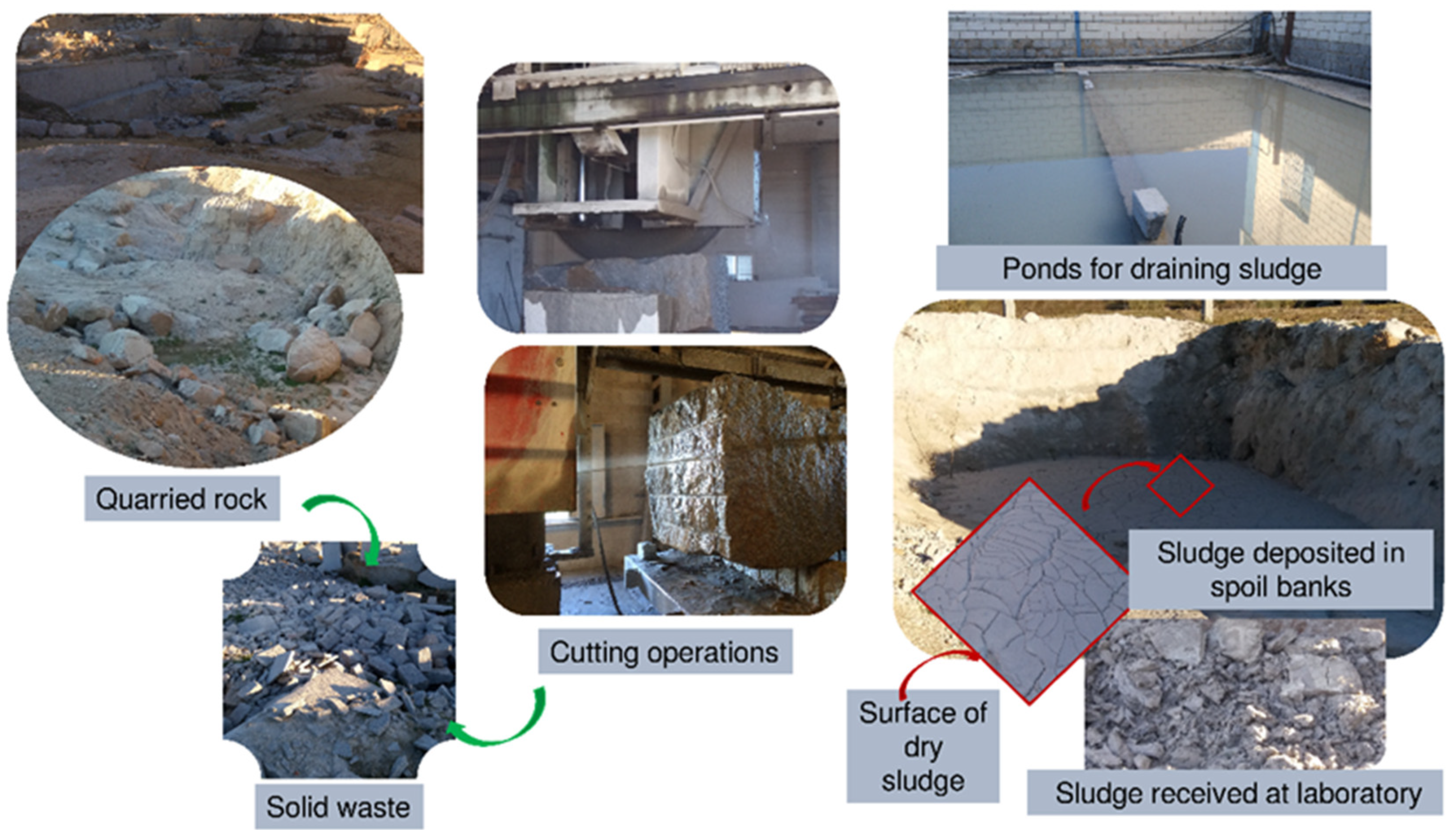

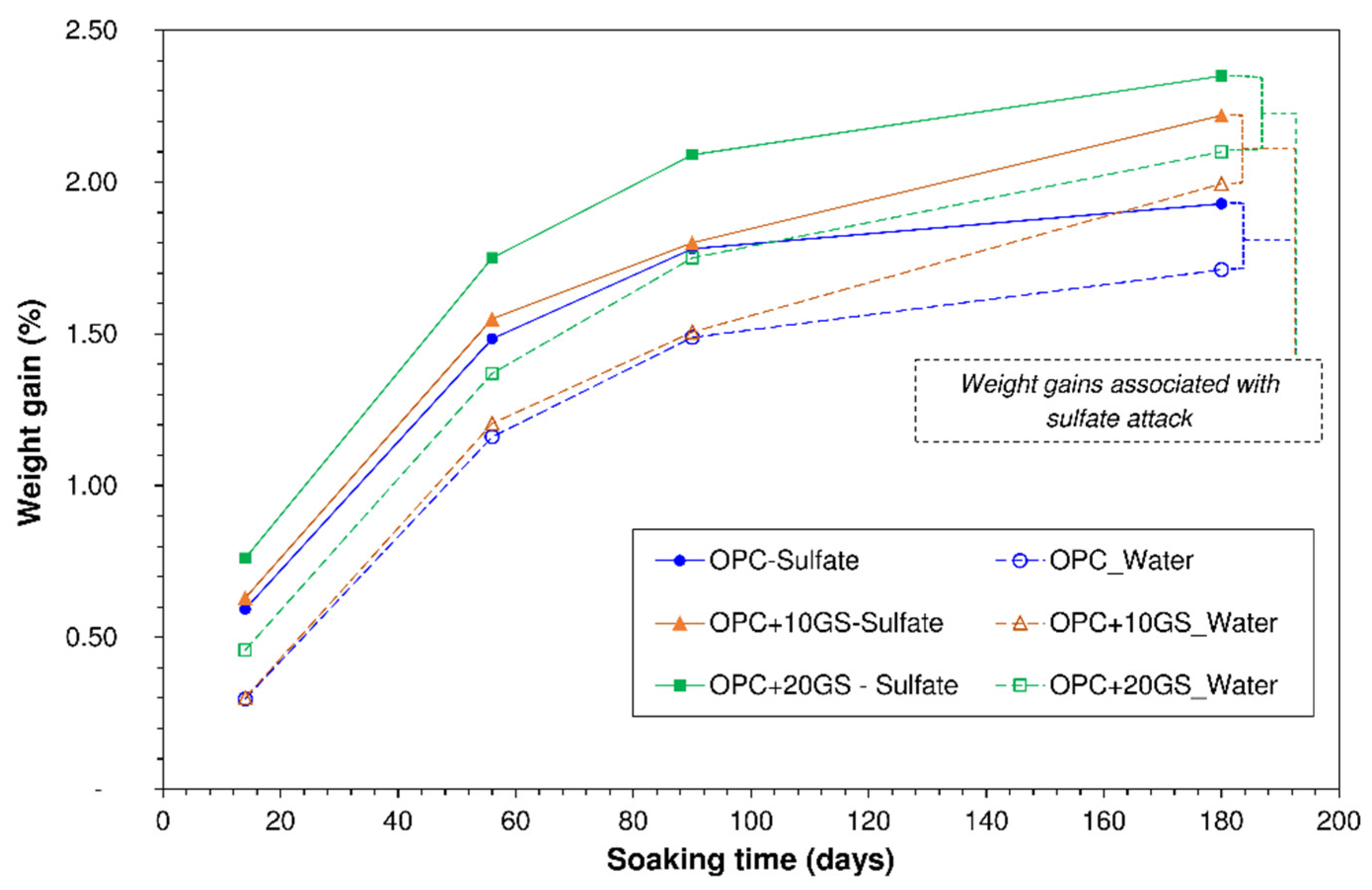

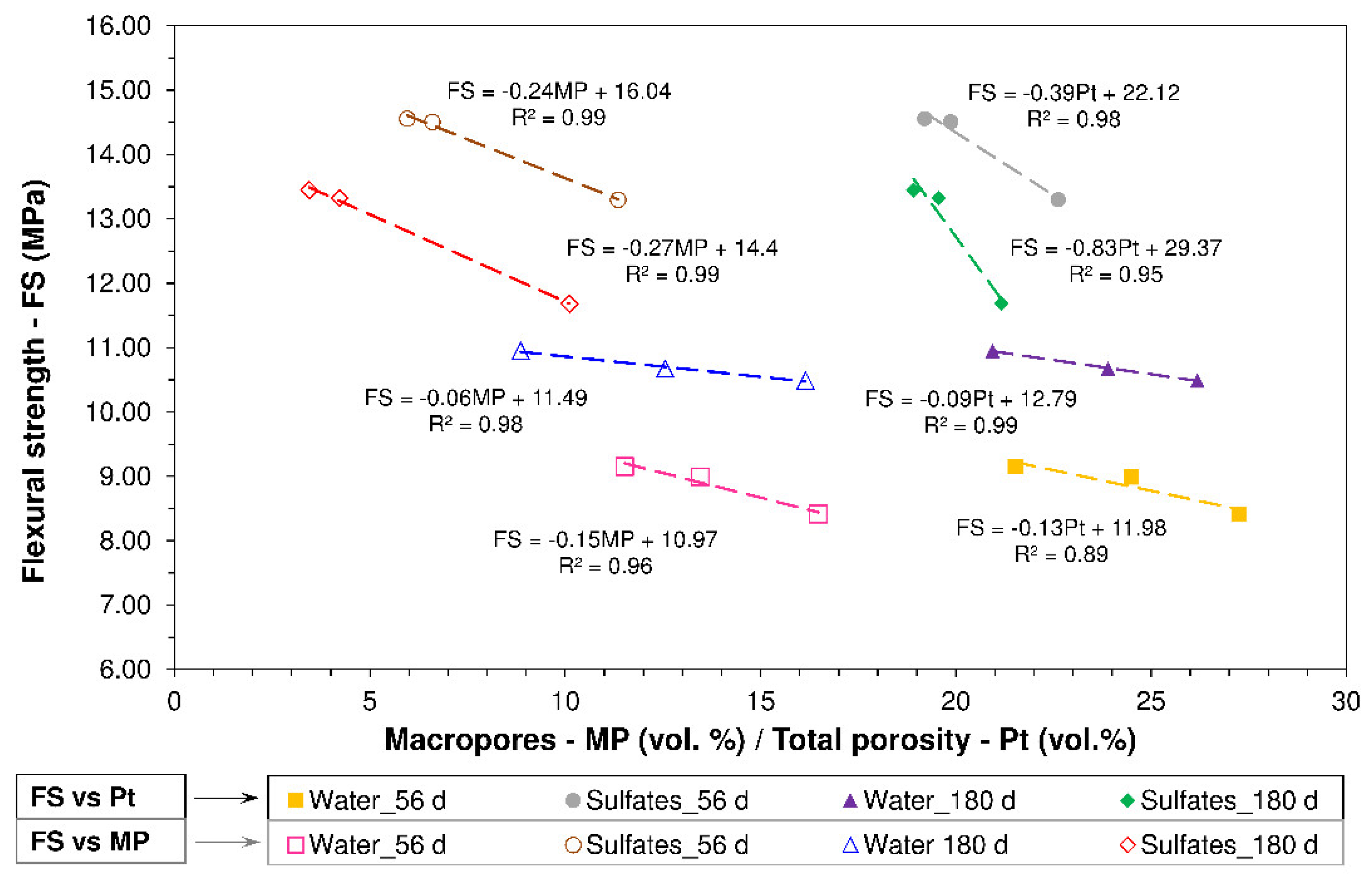
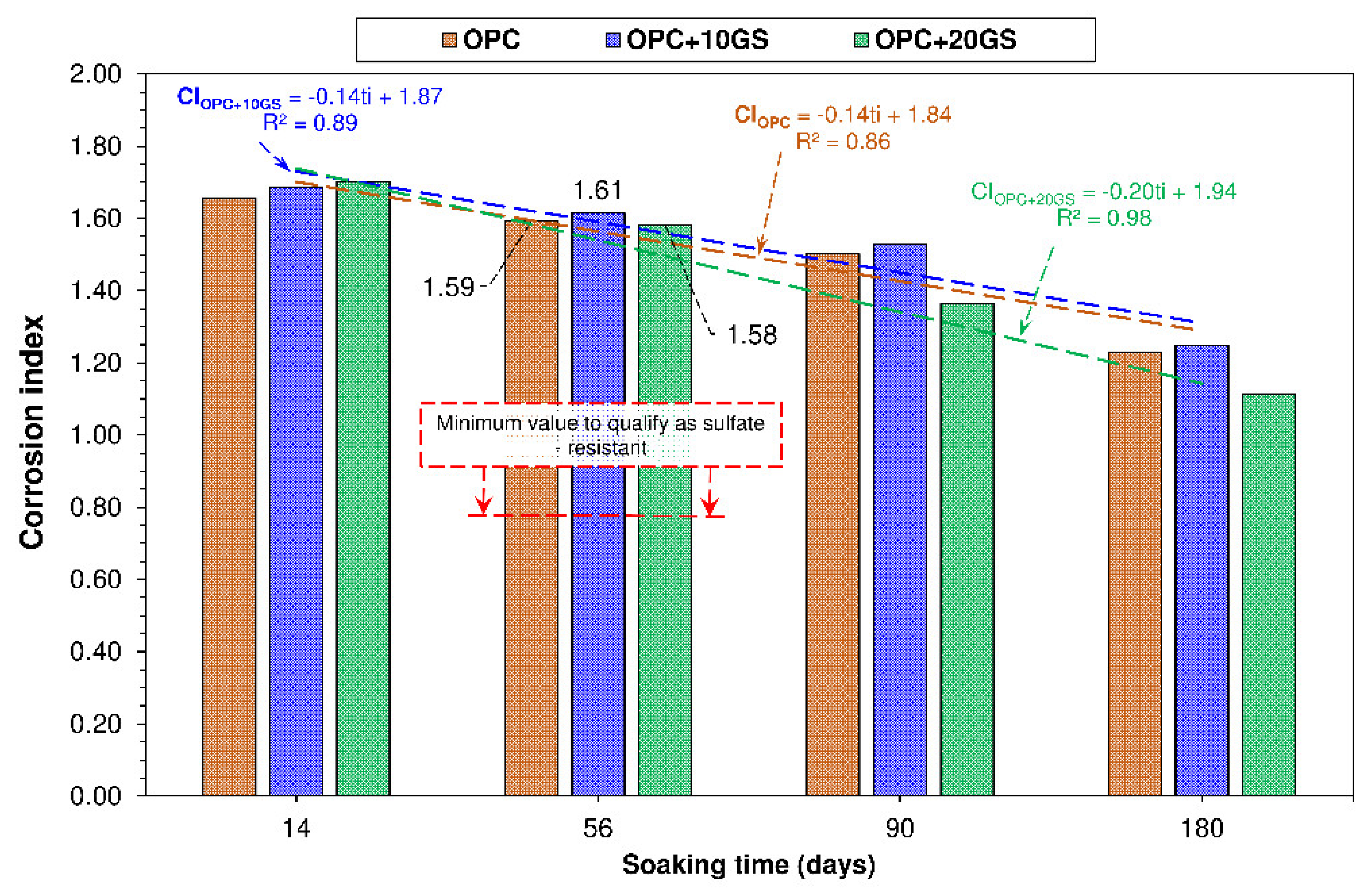
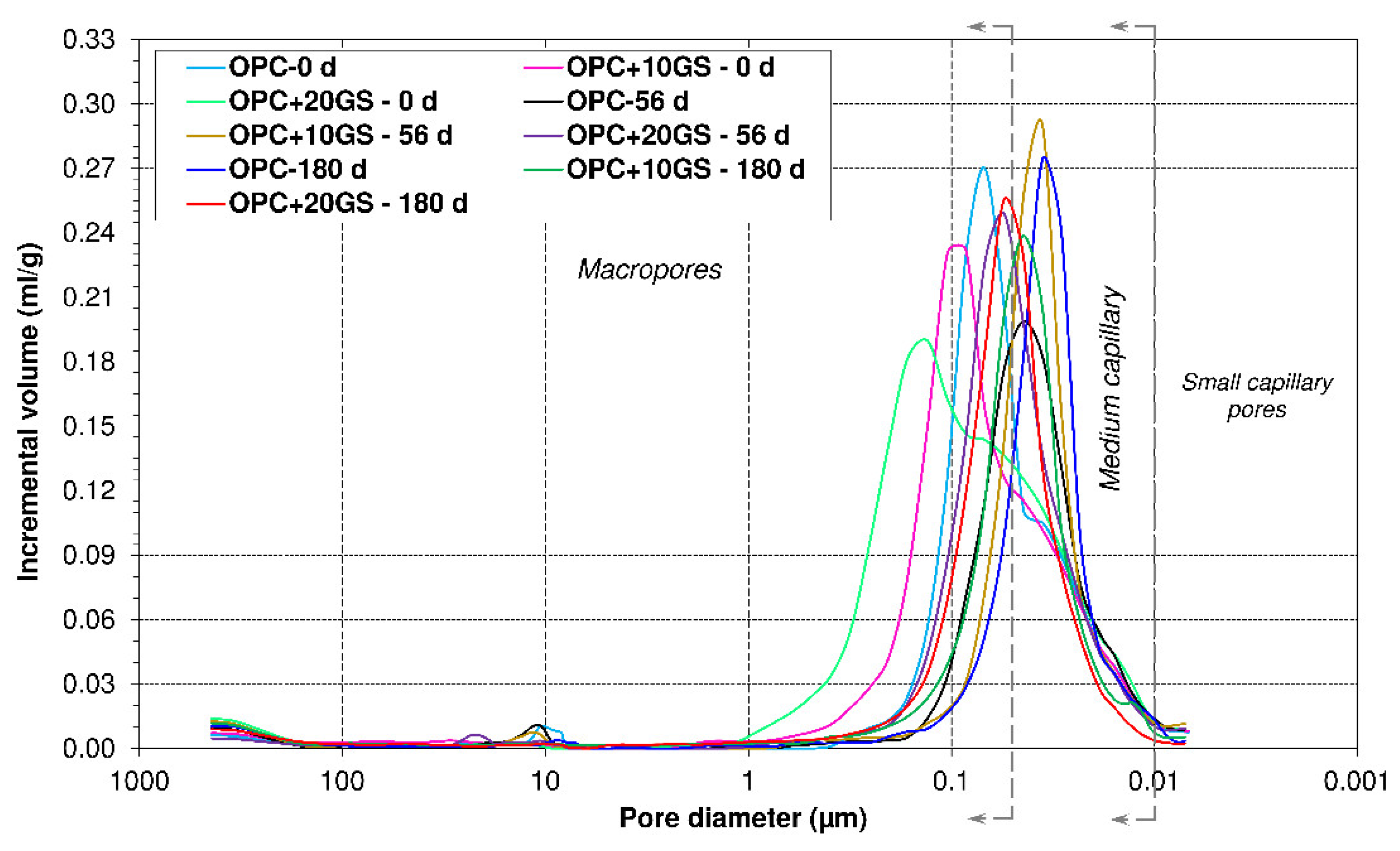

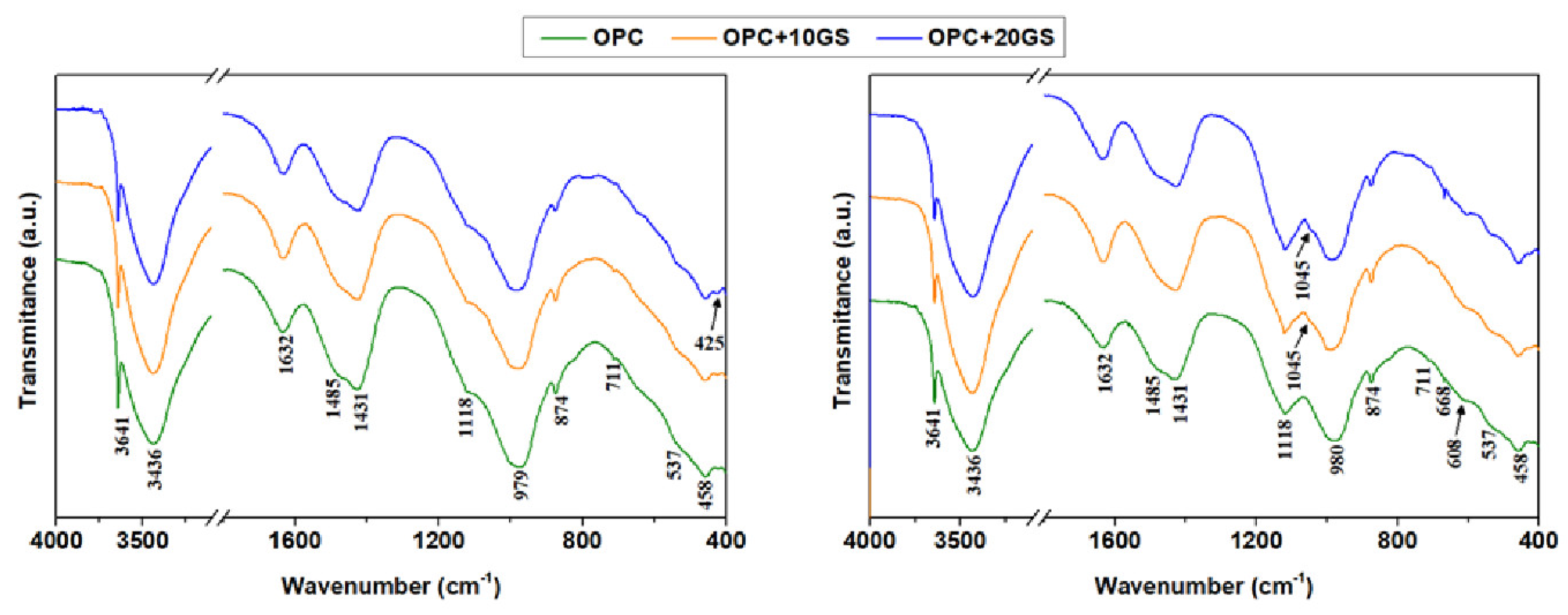
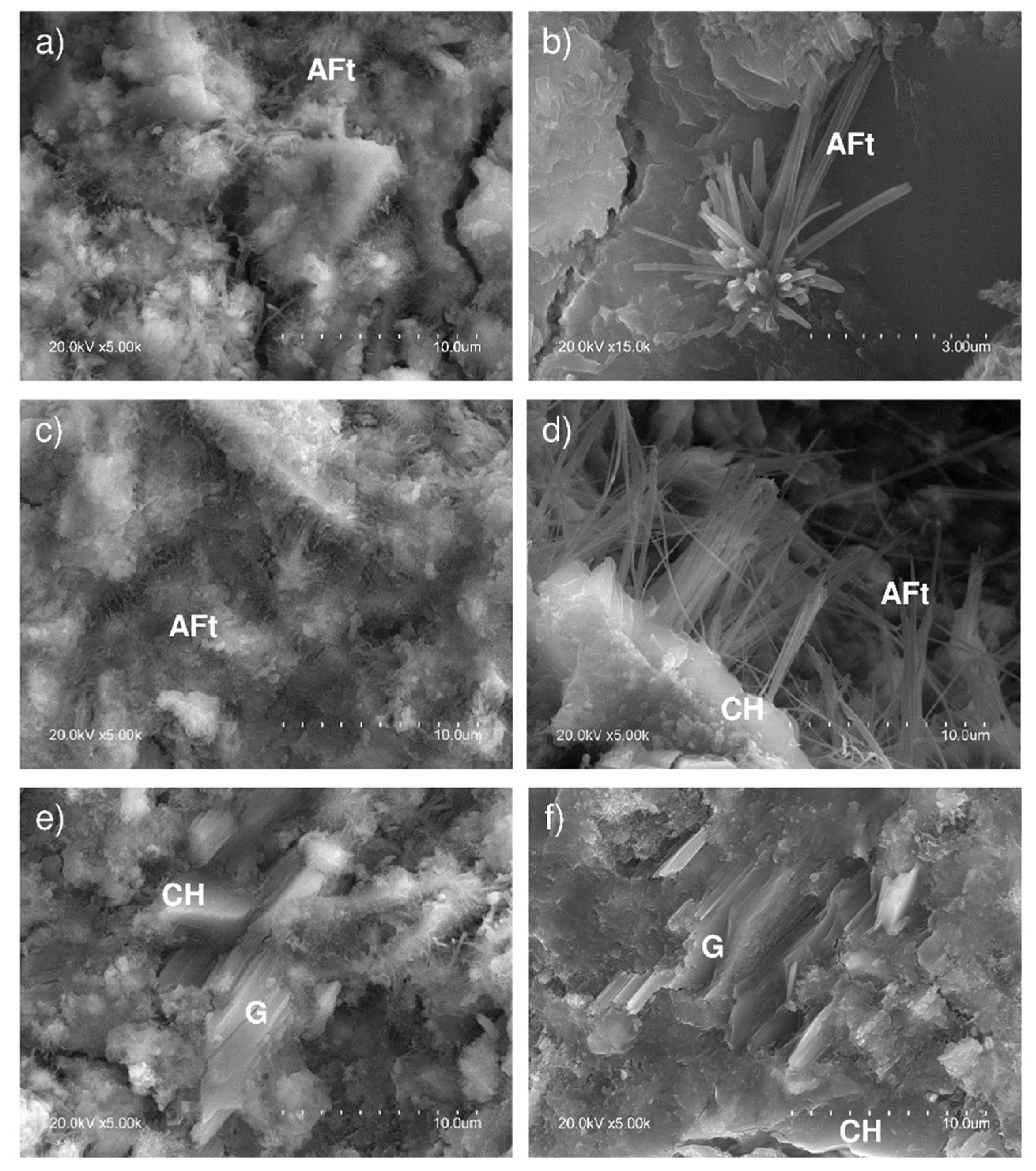
| Property | Blended Cement | EN 197-1 Requirement | ||||
|---|---|---|---|---|---|---|
| OPC | OPC + 10GS | OPC + 20GS | ||||
| Physical | BET specific surface (m2/g) | 1.37 | 1.34 | 1.32 | - | |
| Initial setting time (min) | 210 | 150 | 170 | ≥60.00 | ||
| Expansion (mm) | 1 | 1 | 1 | ≤10.00 | ||
| Mechanical | Compressive strength (MPa) | 2 day | 42.25 | 37.06 | 31.19 | ≥20.00 |
| 28 day | 65.67 | 58.08 | 51.12 | ≥42.50 | ||
| Chemical | Sulfate oxide content (% wt.) | 3.14 | 2.83 | 2.51 | ≤4.00 | |
| Chloride content (ppm) | 0.01 | 0.01 | 0.02 | ≤0.10 | ||
| Pozzolanicity | - | - | Positive | Positive * | ||
| Time | Medium | OPC | OPC + 10GS | OPC + 20GS |
|---|---|---|---|---|
| 14 | Water | 8.87 ± 0.54 | 8.56 ± 0.35 | 7.87 ± 0.35 |
| Sulfates | 14.70 ± 0.69 | 14.44 ± 0.96 | 13.40 ± 0.88 | |
| 56 | Water | 9.15 ± 0.78 | 8.99 ± 0.75 | 8.41 ± 0.40 |
| Sulfates | 14.56 ± 0.93 | 14.51 ± 0.93 | 13.30 ± 0.89 | |
| 90 | Water | 9.56 ± 0.50 | 9.60 ± 0.66 | 9.54 ± 0.49 |
| Sulfates | 14.36 ± 0.75 | 14.68 ± 0.79 | 13.01 ± 0.96 | |
| 180 | Water | 10.95 ± 0.52 | 10.67 ± 0.64 | 10.49 ± 0.58 |
| Sulfates | 13.45 ± 0.68 | 13.32 ± 0.77 | 11.68 ± 0.75 |
| Exposure Time (Days) | Medium | Property | OPC | OPC+ 10GS | OPC + 20GS |
|---|---|---|---|---|---|
| 0 | Water | Pt (vol.%) | 23.26 | 24.74 | 28.13 |
| MP (vol.%) | 13.59 | 16.12 | 19.08 | ||
| CP (vol.%) | 8.37 | 8.07 | 8.40 | ||
| MPD (μm) | 0.042 | 0.048 | 0.054 | ||
| 56 | Water | Pt (vol.%) | 21.52 | 24.49 | 27.26 |
| MP (vol.%) | 11.53 | 13.46 | 16.48 | ||
| CP (vol.%) | 9.62 | 10.61 | 10.09 | ||
| MPD (μm) | 0.040 | 0.038 | 0.042 | ||
| Sulfates | Pt (vol.%) | 19.20 | 19.87 | 22.62 | |
| MP (vol.%) | 5.95 | 6.60 | 11.35 | ||
| CP (vol.%) | 12.74 | 12.87 | 11.02 | ||
| MPD (μm) | 0.034 | 0.033 | 0.040 | ||
| 180 | Water | Pt (vol.%) | 20.94 | 23.90 | 26.19 |
| MP (vol.%) | 8.86 | 12.56 | 16.15 | ||
| CP (vol.%) | 11.74 | 11.10 | 9.73 | ||
| MPD (μm) | 0.034 | 0.036 | 0.043 | ||
| Sulfates | Pt (vol.%) | 18.92 | 19.56 | 21.17 | |
| MP (vol.%) | 3.45 | 4.22 | 10.11 | ||
| CP (vol.%) | 14.94 | 15.00 | 10.99 | ||
| MPD (μm) | 0.032 | 0.032 | 0.039 |
© 2020 by the authors. Licensee MDPI, Basel, Switzerland. This article is an open access article distributed under the terms and conditions of the Creative Commons Attribution (CC BY) license (http://creativecommons.org/licenses/by/4.0/).
Share and Cite
Medina, G.; Sáez del Bosque, I.F.; Frías, M.; Sánchez de Rojas, M.I.; Medina, C. Sulfate Resistance in Cements Bearing Ornamental Granite Industry Sludge. Materials 2020, 13, 4081. https://doi.org/10.3390/ma13184081
Medina G, Sáez del Bosque IF, Frías M, Sánchez de Rojas MI, Medina C. Sulfate Resistance in Cements Bearing Ornamental Granite Industry Sludge. Materials. 2020; 13(18):4081. https://doi.org/10.3390/ma13184081
Chicago/Turabian StyleMedina, Gabriel, Isabel F. Sáez del Bosque, Moisés Frías, María Isabel Sánchez de Rojas, and César Medina. 2020. "Sulfate Resistance in Cements Bearing Ornamental Granite Industry Sludge" Materials 13, no. 18: 4081. https://doi.org/10.3390/ma13184081





